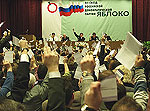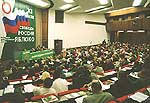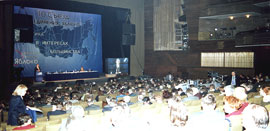Grigory Yavlinsky: What threatens Putin and what threatens Russia
Grigory Yavlinsky’s web-site, 26.02.2021
423 agents of “foreign secret services” were identified in Russia in 2020, as Vladimir Putin said. At the meeting of the Board of the Federal Security Service, Putin spoke about the key, in his view, modern threats to Russia: spies, terrorists, hackers and opponents of the Sputnik V [vaccine against COVID]. These threats are, certainly, along the “external perimeter”. The external enemy again wants to “undermine the values that unite Russian society, ultimately weaken Russia and put it under external control”.
5,716 cases were opened after the protest actions in Moscow in late January – early February this year. 1,251 people were arrested. They are not spies or terrorists. They did not threaten with anything and do not threaten the well-being of Russia. And completely different threats, not those that Putin is talking about, took them into the streets.
THREAT NUMBER ONE
– The attitude towards the citizens of Russia as a resource for the realisation of the great super power ambitions and confrontation with the West, growing poverty and lack of rights, ineffective Russian economy of state capitalism and increasing sanctions.
A deliberate policy of saving on the priority needs of people during a calamity – the pandemic, and minimisation of provision of aid to them during this extremely difficult period not only led to a sharp drop in living standards (only according to official data, real disposable incomes of Russians fell by 3.5% over the year, and by 10.6% as of 2013), but also caused a huge excess mortality. Excess mortality in Russia amounted to 358,000 people from April to the end of 2020.
THREAT NUMBER TWO
– Lies, repression and terror instead of dialogue with society.
Repressive and protective actions are not a consequence of fear of people who take to the streets, but signs of a changed nature of the regime, which demonstrates to the public that unauthorised street activity will be severely suppressed. The repressive actions are accompanied by large-scale information campaigns of defaming the political opposition and all those expressing discontent, adding tensions of suppressing dissent, searching for internal enemies and foreign agents.
– “Hybrid” terror and violence through private military companies and “death squads”
These are the instruments of pressure on citizens and implementation of foreign policy adventures that are not subject to laws, unofficial, but possibly closely related to the state. At the same time, the burning question of the possible use of chemical warfare agents inside and outside the country remains on the agenda.
– Willingness to use large-scale violence against protesters and shedding blood, as well as a high likelihood of provocations pushing towards the implementation of this scenario.
The support by the Russian leadership of unprecedented violence against protesters in Belarus, and the rhetoric used by the President and state officials in talking about the recent protests in Russia, leave no doubt that the authorities are ready for large-scale violence against citizens expressing discontent. At the same time, there is virtually no room for legal street protest.
THREAT NUMBER THREE
– Aggressive nationalism, imperial policy towards [Russia’s] neighbours, striving for control over the post-Soviet countries in various forms – from the implementation of the doctrine of limited sovereignty to annexation (first of all, we are talking about Ukraine and Belarus).
– Willingness to sever ties with the democratic world ([Russian Foreign Minister] Lavrov speaks of severing relations with Europe as a fact that has already taken place). But there is still dangerous participation in military conflicts in Syria and a number of African countries.
THREAT NUMBER FOUR
– Political populism transforming into National Bolshevism, the struggle for power through inciting hatred between the poor and the rich and by means of a crowd pumped up by propaganda, when the real problems of the state and society are used only as a tool, and often leading to violent clashes.
The nationalist and the left-populist agenda is being promoted, which creates conditions for redirecting public discontent from the inefficient irremovable government to those whom it points out: external and internal enemies. We should not forget that the situational alliance of civil activists with nationalists and national Bolsheviks has already led to a tragedy. The rise of nationalism and the Russian Marches in the 2000s became a direct prerequisite for dozens of murders in Russia, and then the shift in public consciousness was exploited by the Putin system, which annexed Crimea in 2014 and initiated a bloody war with more than 13,000 victims in East Ukraine.
* * *
These are real threats that Russian citizens face on a daily basis. These are not fictional spy stories, nor undermining propaganda-created [spiritual] bonds. These are threats to people’s lives.
(Based on the decision of the Federal Political Committee of the Yabloko Party of February 19, 2021. The press release on the decision is here.)
Posted: March 1st, 2021 under Economy, Elections, Foreign policy, Freedom of Assembly, Freedom of Speech, Governance, History, Human Rights, Poisoning of Alexei Navalny, Politics, Protests in Russia, Russia-Belarus Relations, Russia-Eu relations, Russia-Ukraine relations, Russian Economy, Situation in Crimea, Social Policies, War in Syria, YABLOKO Against Nationalism, Extremism and Xenophobia, Без рубрики.







